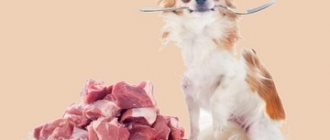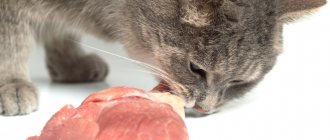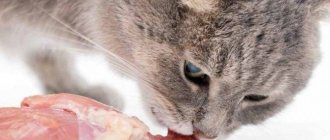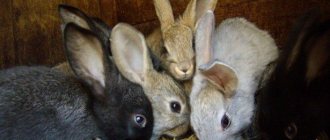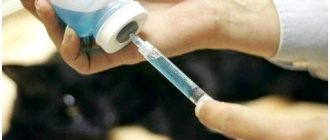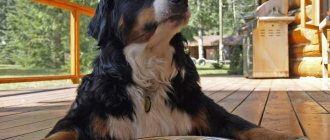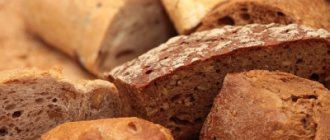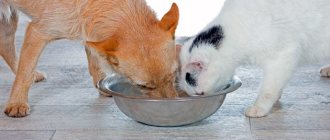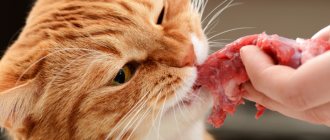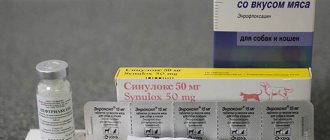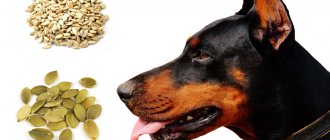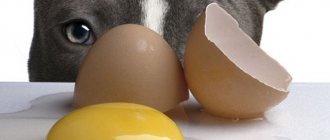Strictly prohibited foods for dogs
There are many foods that can cause irreparable harm to a dog's health. Such food should not be given to your pet under any circumstances.
Prohibited foods for dogs:
- smoked meats;
- spicy, salty, pickled food;
- spices and seasonings;
- bones;
- chocolate;
- sweets;
- alcohol;
- coffee, tea, cocoa;
- baking with yeast;
- grape;
- avocado;
- raisin;
- currant;
- raw fish and meat;
- pork;
- fat meat;
- raw eggs;
- River fish;
- peach;
- citrus;
- persimmon;
- plum;
- pepper;
- nuts;
- pomegranate;
- fruits and berries with seeds;
- mushrooms;
- sorrel,
- spinach;
- rhubarb;
- corn;
- pearl barley;
- millet;
- semolina;
- onion and garlic.
Each of these products can cause many health problems and even kill your pet. It is advisable to remember why this food is dangerous and strictly prohibited.
Forbidden food
Smoked, spicy, pickled and salted foods, as well as seasonings and spices
Due to their excessive fat and salt content, these foods harm the liver, joints, paws and spine, increase blood pressure and lead to obesity. Due to smoked meats, the dog may develop pancreatitis, colitis, and volvulus. Very often, water-salt metabolism is disrupted, which also causes a blow to the body.
Contrary to popular belief, you should not give your dog bones. They injure the gastrointestinal tract and throat and get stuck between the teeth. If a fragment gets stuck in the throat or gastrointestinal tract, serious inflammation begins, then only surgery will help.
No owner in his right mind would drink his pet. All alcoholic drinks, even beer, seriously depress the dog’s nervous system. Due to intoxication, the animal develops paralysis and heart failure, and then the dog dies.
Note! The dog should drink plenty of clean water, but never give it tea or coffee. These drinks contain caffeine, which is dangerous for the nervous system and heart.
Fruits and berries should be in the diet, but you must choose only healthy and safe foods
Chocolate, baked goods, raw eggs
Chocolate contains theobromine, which is no less dangerous for animals than alcohol. Because of chocolate, the dog’s heart rhythm is disturbed, seizures and other neurological disorders begin. If a dog eats too much chocolate, he may die without emergency medical attention. Any other sweets are also prohibited. Because of them, the dog’s digestion is disrupted, diabetes develops, excess weight appears, and teeth are destroyed.
Baking made from yeast dough (buns, buns with poppy seeds, pancakes, muffins, etc.) provokes the fermentation process in the digestive tract. Because of this, acute colic can occur, and sometimes perforation of the intestinal wall.
Note! A little milk should only be given to puppies under 12 months of age. In adults it causes diarrhea.
A dog is a carnivore, so it must eat a lot of meat. Every dog lover knows what meat to choose and how to cook it. You cannot feed your animal raw meat and fish. By eating these foods, your dog can become infected with worms and protozoa. Uncleaned fish is especially dangerous: it contains many small bones that can injure the dog.
Raw eggs contain substances that interfere with the absorption of vitamin B1. Through them you can become infected with salmonellosis. You can pick up several types of parasites at once through pork. In addition, this type of meat is difficult to digest, so it should not be given to pets. It is worth giving up fatty meat and offal. The best types of fish to give your dog are hake, pollock, cod, salmon, and salmon. Many dogs are allergic to chicken meat, so it needs to be replaced with beef.
Dangerous products will cause irreparable harm to your pet.
Fruits and vegetables
There are many vegetables, fruits and berries that are harmful to dogs. Persimmon, plum and peach cause intestinal obstruction. Grapes, currants (any) and raisins provoke kidney failure.
Many owners ask if dogs can eat avocados. This is a strictly prohibited, poisonous product. Avocados contain persin, a toxic substance that causes poisoning.
You need to give up fruits and berries with seeds. Moreover, it is forbidden for a dog to swallow fruit along with the seed. This will lead to intestinal obstruction. In addition, the seeds of many fruits (peaches, apricots, pomegranates, etc.) contain hydrocyanic acid, which causes severe poisoning. Citrus fruits are strictly prohibited: oranges, tangerines, grapefruit, lemon.
Note! Onions, garlic and peppers contain thiosulfates. These substances disrupt the process of hematopoiesis and cause anemia.
You should not feed dogs nuts, as this product is not digestible and leads to intestinal obstruction, the treatment of which will require emergency surgery. All types of nuts are prohibited: walnuts, peanuts, coconut, hazelnuts, almonds, etc.
Owners often ask if dogs can eat grains. These products should be present in the diet in small quantities. It is important to remember which types of grains your dog can eat and which ones he cannot. Corn, millet and hops are prohibited, as well as porridges made from pearl barley, wheat, semolina and corn. Greens that dogs cannot eat include sorrel, spinach and rhubarb. These plants contain a lot of oxalates, which cause kidney and urinary problems.
Note! Mushrooms, including champignons, are rich in quinine, which can lead to severe poisoning.
Dangerous food most often ends up on the household table. Products from the human table (soup, borscht, vinaigrette, mayonnaise, etc.), as well as spoiled or rotten food, should absolutely not be given to dogs. Owners who feed their pet such food must urgently take it to the veterinary clinic.
A knowledgeable veterinarian should prescribe the diet.
Basic rules for feeding dogs
Many inexperienced breeders very often confuse the principle of proper nutrition with an excess of food in the animal’s diet. There are some dog breeds that are insatiable by nature. Such dogs have practically no sense of proportion when it comes to food, and the good-natured owner thinks that his pet is constantly hungry, and he begins to put another portion of treats in his bowl. Dogs that cannot distinguish hunger from satiety begin to gain weight right before our eyes. Such overly well-fed dogs develop obesity, which provokes diseases of the gastrointestinal tract, heart and joints. In such cases, caring owners shorten the dog's age with their “good” actions.
If you decide to get a dog or are already the happy owner of a four-legged pet, then the advice of experienced breeders and professional veterinarians, selected in today’s article, will help you decide on a middle ground regarding the dog’s diet. Every caring owner, first of all, must know how much and what to feed the dog in order to satisfy its hunger and satisfy its body’s daily need for nutrients, but not to overfeed or, conversely, not to keep the pet from hand to mouth.
Products that are not recommended for consumption
Some foods are less dangerous, but can also cause harm, so feeding them to your dog is not recommended.
What not to give to dogs:
- potatoes (in any form);
- bread;
- legumes;
- celery.
These products should be excluded from the dog's diet. All legumes cause increased gas formation and digestive problems, so you should not put beans, lentils, peas, etc. in a dog’s bowl. Raw potatoes contain substances that are poisonous to dogs, poisoning with which can lead to death. Boiled potatoes are relatively safe, but absolutely useless for the dog.
Note! Occasionally, you can pamper your dog with unleavened crackers (not overcooked and without additives). But bread and other flour products will harm him.
Celery is very tough, so if it gets into the digestive tract of a predator (dog), it can clog the passage and cause obstruction. However, celery contains many vitamins. Therefore, this plant must be finely chopped or ground in a meat grinder to obtain a paste.
Not recommended products
Approximate daily diet
We provide an approximate diet for a puppy up to two months. Based on it, taking into account age-related needs, it is easy to create a routine for a child of any age.
Meal:
- First. Cottage cheese or porridge.
- Second. Cereals, vegetables, meat. Mix porridge cooked in broth with boiled chopped vegetables and meat. Part of the meat feed is given raw.
- Third. Dairy products. Yogurt, kefir or milk. This meal is essentially a light snack.
- Fourth. Cereals with meat and vegetables.
- Fifth. Dairy products or porridge with milk.
- Sixth. Fish or meat. It is better not to give dairy or liquid foods before bedtime so that the baby sleeps better and asks to go to the toilet less often.
As the dog gets older, dairy products are removed from the dog's diet. By the age of 10 months, it is enough to give them 1-2 times a week.
Foods to be given in moderation
Some foods are only allowed to be given to dogs in small quantities. A sense of proportion is very important here.
List:
- low-fat cottage cheese and cheese;
- kefir;
- rice;
- apple;
- blueberry;
- strawberry;
- banana;
- pear;
- melon;
- pumpkin;
- cabbage.
Beginning dog breeders are interested in whether a puppy can have cow's milk. It is acceptable to pour a little milk into a bowl, but it should only be given to puppies up to one year old. For adult dogs, it is better to offer low-fat fermented milk products, such as low-fat cottage cheese, kefir or plain yogurt. Low-fat cheese will also be a good treat. You can have some boiled rice or rice porridge.
As for vegetables, dogs are allowed to give cabbage. As for fruits, the dog can eat apples, strawberries, bananas, pumpkins, melons, pears and seedless berries. A little boiled grated beets will benefit your pet.
In moderation
What to feed
The food of a small dog must be balanced, including all the necessary components for proper growth, weight, and development.
Dairy
Required up to 3.5 months. Milk is used as a base for porridges and separately. Natural yogurt, kefir or yogurt are useful. Cottage cheese with added calcium is a very valuable and nutritious food. Do not use foods that are too fatty - they will cause stomach upset. But don’t give completely low-fat ones either - this is “empty”, useless food.
Meat
From three months it is the basis of the diet. The main percentage should be beef or veal. You can give lean lamb, rabbit, turkey, chicken. It is better to avoid pork - it is too difficult to digest and fatty. The meat is given frozen or boiled until half cooked. Cut into small pieces. It is good to add heart, lungs and especially liver to meat food - animals love it, and it is very healthy. The required amount of meat feed is about 30 grams per kilogram of animal weight. In adults the need is lower.
Fish
Have “fish days” at least a couple of times a week. Sea fish is given raw, frozen or scalded with boiling water. River fish needs to be boiled, as there is a high risk of finding parasites in it. Before feeding, remove the bones - the animal may be injured by them. If your baby, even after a long break, flatly refuses fish, do not force him, it is better to increase the amount of meat in his diet.
Fruits
A good source of vitamins and fiber, which aids digestion. They should be present in the form of treats. Excess may lead to stomach upset.
Vegetables
They must be present in the food every day. Finely chop the boiled vegetables and add to the main food. It's best not to use more than one variety at a time.
Cereals
This is one of the basics of a dog's diet. Oatmeal, millet, rice, and buckwheat porridge are cooked in broth with the addition of meat and vegetables. Try to change the type of cereal and the “recipe” so that the baby does not get bored with the porridge. Twice a week it is good to add a boiled egg to the porridge.
Do not forget that you only provide food during meals, but your pet should always have water. Make sure that the drink in the bowl is fresh and not running out.
In what form to give
It is best to feed your dog raw meat; it is much healthier for the animal. The digestive system of canines is adapted by nature specifically for digesting raw meat. At the same time, special digestive enzymes in gastric juice neutralize most pathogenic bacteria.
An alternative to raw meat is boiled meat.
More boiled meat is required, but it is digested worse and brings much less benefit. It is recommended to boil meat only if there is doubt about its quality.
It is forbidden to give fried or smoked meat to dogs.
Raw meat is given in large pieces so that the dog has to tear them with his teeth and chew them. This promotes natural teeth cleaning. The exception is small breeds of dogs. It is better to give them small pieces.
Bones are only given raw. Boiled bone can cause constipation.
How many times a day should you feed your dog?
While the puppy was still small, we had to feed him literally by the hour. But already at the age of one year, the diet is divided into one or two feedings. Some owners prefer to feed in the morning and evening, while others feed only before bed. Veterinarians consider both options acceptable, although the first is still better.
Important!
A sick or old dog should be fed light, low-fat food, dividing the usual diet into 3-4 meals for better digestion.
If the animal is not prescribed a different regime, then the question “feed the dog before or after a walk” should not be relevant at all. And this is not a matter of habit of the dog or the owner - doctors are unanimous on this matter - you can give your pet food only after a walk, and not vice versa. The fact is that a dog’s gastrointestinal tract is designed in such a way that when overfilled with food during active movement, it can twist, forming a volvulus of the stomach and part of the intestines. Therefore, first an active walk, and then food.
If there is a need to feed the animal before walking (it cannot recover normally without replenishing its stomach with food), then the walk in this case should take place in an inactive form, only to relieve its natural needs. Only after an hour will the dog be allowed to frolic to his heart's content.
Important!
In winter, when it is cold, the amount and calorie content of food for the dog kept in the enclosure should be increased.
